Tropical Cyclone Landfall Frequency and Large-Scale Environmental Impacts along Karstic Coastal Regions (Yucatan Peninsula, Mexico)
Abstract
:1. Introduction
2. Materials and Methods
2.1. Area Description
2.2. Tropical Cyclones
2.3. Rain Gauge and Drainage Networks
2.4. Satellite Products
3. Results
3.1. Tropical Cyclones
3.2. TCs Impacts: Emily, Stan, Wilma, and Dean
3.2.1. Cloud Cover
3.2.2. Rainfall and River Discharge
3.2.3. Enhanced Vegetation Index (EVI) Spatial Patterns
3.2.4. Coastal Chl-a Concentrations
4. Discussion
4.1. Historical and Future Hurricane Frequency, Intensity, and Landfall
4.2. Precipitation and River Discharge Spatiotemporal Patterns Induced by TC Impacts
4.3. TC Impacts on Terrestrial Vegetation and Chl-a Concentration in Coastal Waters
4.4. Regional Socio-Ecological and Economic Impacts under Climate Change
5. Summary and Conclusions
Supplementary Materials
Author Contributions
Funding
Acknowledgments
Conflicts of Interest
References
- Anthes, R.A. Tropical Cyclones, Their Evolution, Structure and Effects; American Metereological Society: Boston, MA, USA, 1982. [Google Scholar] [CrossRef]
- Kousky, C. Disasters as Learning Experiences or Disasters as Policy Opportunities? Examining Flood Insurance Purchases after Hurricanes. Risk Anal. 2017, 37, 517–530. [Google Scholar] [CrossRef]
- Auffhammer, M. Quantifying Economic Damages from Climate Change. J. Econ. Perspect. 2018, 32, 33–52. [Google Scholar] [CrossRef] [Green Version]
- Diaz, D.; Moore, F. Quantifying the economic risks of climate change. Nat. Clim. Chang. 2017, 7, 774–782. [Google Scholar] [CrossRef]
- Paerl, H.W.; Bales, J.D.; Ausley, L.W.; Buzzelli, C.P.; Crowder, L.B.; Eby, L.A.; Fear, J.M.; Go, M.; Peierls, B.L.; Richardson, T.L.; et al. Ecosystem impacts of three sequential hurricanes (Dennis, Floyd, and Irene) on the United States’ largest lagoonal estuary, Pamlico Sound, NC. Proc. Natl. Acad. Sci. USA 2001, 98, 5655–5660. [Google Scholar] [CrossRef] [Green Version]
- Paerl, H.W.; Valdes, L.M.; Peierls, B.L.; Adolf, J.E.; Harding, L.W. Anthropogenic and climatic influences on the eutrophication of large estuarine ecosystems. Limnol. Oceanogr. 2006, 51, 448–462. [Google Scholar] [CrossRef] [Green Version]
- Greening, H.; Doering, P.; Corbett, C. Hurricane impacts on coastal ecosystems. Estuaries Coasts 2006, 29, 877–879. [Google Scholar] [CrossRef]
- Tanner, E.V.J.; Kapos, V.; Healey, J.R. Hurricane Effects on Forest Ecosystems in the Caribbean. Biotropica 1991, 23, 513–521. [Google Scholar] [CrossRef]
- Lugo, A.E. Visible and invisible effects of hurricanes on forest ecosystems: An international review. Austral Ecol. 2008, 33, 368–398. [Google Scholar] [CrossRef]
- Day, J.W.; Boesch, D.F.; Clairain, E.J.; Kemp, G.P.; Laska, S.B.; Mitsch, W.J.; Orth, K.; Mashriqui, H.; Reed, D.J.; Shabman, L.; et al. Restoration of the Mississippi Delta: Lessons from Hurricanes Katrina and Rita. Science 2007, 315, 1679–1684. [Google Scholar] [CrossRef] [PubMed] [Green Version]
- Nyman, J.A.; Delaune, R.D.; Pezeshki, S.R.; Patrick, W.H. Organic-Matter Fluxes and Marsh Stability in a Rapidly Submerging Estuarine Marsh. Estuaries 1995, 18, 207–218. [Google Scholar] [CrossRef]
- Smith, J.E.; Bentley, S.J.; Snedden, G.A.; White, C. What Role do Hurricanes Play in Sediment Delivery to Subsiding River Deltas? Sci. Rep. 2015, 5, 1–8. [Google Scholar] [CrossRef] [PubMed]
- Wang, W.T.; Qu, J.J.; Hao, X.J.; Liu, Y.Q.; Stanturf, J.A. Post-hurricane forest damage assessment using satellite remote sensing. Agric. For. Meteorol. 2010, 150, 122–132. [Google Scholar] [CrossRef]
- Potter, C. Global assessment of damage to coastal ecosystem vegetation from tropical storms. Remote Sens. Lett. 2014, 5, 315–322. [Google Scholar] [CrossRef] [Green Version]
- Tapia-Palacios, M.A.; Garcia-Suarez, O.; Sotomayor-Bonilla, J.; Silva-Magana, M.A.; Perez-Ortiz, G.; Espinosa-Garcia, A.C.; Ortega-Huerta, M.A.; Diaz-Avalos, C.; Suzan, G.; Mazari-Hiriart, M. Abiotic and biotic changes at the basin scale in a tropical dry forest landscape after Hurricanes Jova and Patricia in Jalisco, Mexico. For. Ecol. Manag. 2018, 426, 18–26. [Google Scholar] [CrossRef]
- Castaneda-Moya, E.; Rivera-Monroy, V.H.; Chambers, R.M.; Zhao, X.C.; Lamb-Wotton, L.; Gorsky, A.; Gaiser, E.E.; Troxler, T.G.; Kominoski, J.S.; Hiatt, M. Hurricanes fertilize mangrove forests in the Gulf of Mexico (Florida Everglades, USA). Proc. Natl. Acad. Sci. USA 2020, 117, 4831–4841. [Google Scholar] [CrossRef] [PubMed]
- Knutson, T.R.; McBride, J.L.; Chan, J.; Emanuel, K.; Holland, G.; Landsea, C.; Held, I.; Kossin, J.P.; Srivastava, A.K.; Sugi, M. Tropical cyclones and climate change. Nat. Geosci. 2010, 3, 157–163. [Google Scholar] [CrossRef] [Green Version]
- Conner, W.H.; Duberstein, J.A.; Day, J.W.; Hutchinson, S. Impacts of changing hydrology and hurricanes on forest structure and growth along a flooding/elevation gradient in a South Louisiana forested wetland from 1986 to 2009. Wetlands 2014, 34, 803–814. [Google Scholar] [CrossRef]
- Gardner, T.A.; Cote, I.M.; Gill, J.A.; Grant, A.; Watkinson, A.R. Hurricanes and Caribbean coral reefs: Impacts, recovery patterns, and role in long-term decline. Ecology 2005, 86, 174–184. [Google Scholar] [CrossRef] [Green Version]
- Smith, T.J.; Anderson, G.H.; Balentine, K.; Tiling, G.; Ward, G.A.; Whelan, K.R.T. Cumulative impacts of hurricanes on Florida mangrove ecosystems: Sediment deposition, storm surges and vegetation. Wetlands 2009, 29, 24–34. [Google Scholar] [CrossRef]
- Hopkinson, C.S.; Lugo, A.E.; Alber, M.; Covich, A.P.; Van Bloem, S.J. Forecasting effects of sea-level rise and windstorms on coastal and inland ecosystems. Front. Ecol. Environ. 2008, 6, 255–263. [Google Scholar] [CrossRef] [Green Version]
- Haig, J.; Nott, J.; Reichart, G.J. Australian tropical cyclone activity lower than at any time over the past 550–1500 years. Nature 2014, 505, 667–671. [Google Scholar] [CrossRef] [PubMed]
- Farfan, L.M.; Zehnder, J.A. Orographic influence on the synoptic-scale circulations associated with the genesis of Hurricane Guillermo (1991). Mon. Weather Rev. 1997, 125, 2683–2698. [Google Scholar] [CrossRef]
- Lin, T.-C.; Hogan, J.A.; Chang, C.-T. Tropical Cyclone Ecology: A Scale-Link Perspective. Trends Ecol. Evol. 2020, in press. [Google Scholar] [CrossRef] [PubMed] [Green Version]
- Zhang, G.; Murakami, H.; Knutson, T.R.; Mizuta, R.; Yoshida, K. Tropical cyclone motion in a changing climate. Sci. Adv. 2020, 6, eaaz7610. [Google Scholar] [CrossRef] [PubMed] [Green Version]
- Lavender, S.L.; Dowdy, A.J. Tropical cyclone track direction climatology and its intraseasonal variability in the Australian region. J. Geophys. Res. Atmos. 2016, 121, 13236–13249. [Google Scholar] [CrossRef] [Green Version]
- Avila, L.A.; Pasch, R.J. ATLANTIC TROPICAL SYSTEMS OF 1993. Mon. Weather Rev. 1995, 123, 887–896. [Google Scholar] [CrossRef] [Green Version]
- Landsea, C.W.; Pielke, R.A.; Mestas-Nunez, A.; Knaff, J.A. Atlantic basin hurricanes: Indices of climatic changes. Clim. Chang. 1999, 42, 89–129. [Google Scholar] [CrossRef]
- Landsea, C.W.; Vecchi, G.A.; Bengtsson, L.; Knutson, T.R. Impact of Duration Thresholds on Atlantic Tropical Cyclone Counts. J. Clim. 2010, 23, 2508–2519. [Google Scholar] [CrossRef]
- Zehnder, J.A.; Powell, D.M.; Ropp, D.L. The interaction of easterly waves, orography, and the intertropical convergence zone in the genesis of eastern Pacific tropical cyclones. Mon. Weather Rev. 1999, 127, 1566–1585. [Google Scholar] [CrossRef]
- Farfan, L.M.; D’Sa, E.J.; Liu, K.-b.; Rivera-Monroy, V.H. Tropical Cyclone Impacts on Coastal Regions: The Case of the Yucatan and the Baja California Peninsulas, Mexico. Estuaries Coasts 2014, 37, 1388–1402. [Google Scholar] [CrossRef]
- Cortes-Ramos, J.; Farfan, L.M.; Herrera-Cervantes, H. Assessment of tropical cyclone damage on dry forests using multispectral remote sensing: The case of Baja California Sur, Mexico. J. Arid Environ. 2020, 178. [Google Scholar] [CrossRef]
- Metcalfe, S.E.; O’Hara, S.L.; Caballero, M.; Davies, S.J. Records of Late Pleistocene-Holocene climatic change in Mexico—A review. Quat. Sci. Rev. 2000, 19, 699–721. [Google Scholar] [CrossRef]
- Kim, Y.; Miller, M.S.; Pearce, F.; Clayton, R.W. Seismic imaging of the Cocos plate subduction zone system in central Mexico. Geochem. Geophys. Geosyst. 2012, 13. [Google Scholar] [CrossRef] [Green Version]
- Pardo, M.; Suarez, G. Shape of the Subducted Rivera and Cocos Plates in Southern Mexico—Seismic Antitectonic Implications. J. Geophys. Res. Solid Earth 1995, 100, 12357–12373. [Google Scholar] [CrossRef] [Green Version]
- Peel, M.C.; Finlayson, B.L.; McMahon, T.A. Updated world map of the Koppen-Geiger climate classification. Hydrol. Earth Syst. Sci. 2007, 11, 1633–1644. [Google Scholar] [CrossRef] [Green Version]
- Bauer-Gottwein, P.; Gondwe, B.R.N.; Charvet, G.; Marin, L.E.; Rebolledo-Vieyra, M.; Merediz-Alonso, G. Review: The Yucatan Peninsula karst aquifer, Mexico. Hydrogeol. J. 2011, 19, 507–524. [Google Scholar] [CrossRef]
- Escolero, O.A.; Marin, L.E.; Steinich, B.; Pacheco, A.J.; Cabrera, S.A.; Alcocer, J. Development of a protection strategy of karst limestone aquifers: The Merida Yucatan, Mexico case study. Water Resour. Manag. 2002, 16, 351–367. [Google Scholar] [CrossRef]
- Estrada-Allis, S.N.; Pardo, J.S.; De Souza, J.; Ortiz, C.E.E.; Tapia, I.M.; Herrera-Silveira, J.A. Dissolved inorganic nitrogen and particulate organic nitrogen budget in the Yucatan shelf: Driving mechanisms through a physical-biogeochemical coupled model. Biogeosciences 2020, 17, 1087–1111. [Google Scholar] [CrossRef] [Green Version]
- Enriquez, C.; Marino-Tapia, I.J.; Herrera-Silveira, J.A. Dispersion in the Yucatan coastal zone: Implications for red tide events. Cont. Shelf Res. 2010, 30, 127–137. [Google Scholar] [CrossRef]
- Knee, K.; Paytan, A. Submarine Groundwater Discharge: A Source of Nutrients, Metals, and Pollutants to the Coastal Ocean. In Treatise on Estuarine and Coastal Science; Wolanski, E., McLusky, D.S., Eds.; Academic Press: Waltham, MA, USA, 2011; Volume 4, pp. 205–233. [Google Scholar]
- Peierls, B.L.; Christian, R.R.; Paerl, H.W. Water quality and phytoplankton as indicators of hurricane impacts on a large estuarine ecosystem. Estuaries 2003, 26, 1329–1343. [Google Scholar] [CrossRef]
- Winder, M.; Sommer, U. Phytoplankton response to a changing climate. Hydrobiologia 2012, 698, 5–16. [Google Scholar] [CrossRef]
- Vega-Cendejas, M.E.; Hernandez, M.; Arreguin-Sanchez, F. Trophic interrelations in a bech seine fishery from the northwestern coast of the Yucatan peninsula, Mexico. J. Fish Biol. 1994, 44, 647–659. [Google Scholar] [CrossRef]
- Hernandez, A.; Seijo, J.C. Spatial distribution analysis of red grouper (Epinephelus morio) fishery in Yucatan, Mexico. Fish Res. 2003, 63, 135–141. [Google Scholar] [CrossRef]
- Hernandez-Flores, A.; Condal, A.; Poot-Salazar, A.; Espinoza-Mendez, J.C. Geostatistical analysis and spatial modeling of population density for the sea cucumbers Isostichopus badionotus and Holothuria floridana on the Yucatan Peninsula, Mexico. Fish Res. 2015, 172, 114–124. [Google Scholar] [CrossRef]
- Tyminski, J.P.; De la Parra-Venegas, R.; Cano, J.G.; Hueter, R.E. Vertical Movements and Patterns in Diving Behavior of Whale Sharks as Revealed by Pop-Up Satellite Tags in the Eastern Gulf of Mexico. PLoS ONE 2015, 10, e0142156. [Google Scholar] [CrossRef] [PubMed] [Green Version]
- Beven, J.L.; Avila, L.A.; Blake, E.S.; Brown, D.P.; Franklin, J.L.; Knabb, R.D.; Pasch, R.J.; Rhome, J.R.; Stewart, S.R. Atlantic hurricane season of 2005. Mon. Weather Rev. 2008, 136, 1109–1173. [Google Scholar] [CrossRef]
- Brennan, M.J.; Knabb, R.D.; Mainelli, M.; Kimberlain, T.B. Atlantic Hurricane Season of 2007. Mon. Weather Rev. 2009, 137, 4061–4088. [Google Scholar] [CrossRef]
- Sun, D.L.; Lau, K.M.; Kafatos, M. Contrasting the 2007 and 2005 hurricane seasons: Evidence of possible impacts of Saharan dry air and dust on tropical cyclone activity in the Atlantic basin. Geophys. Res. Lett. 2008, 35. [Google Scholar] [CrossRef] [Green Version]
- Walsh, K.J.E.; McBride, J.L.; Klotzbach, P.J.; Balachandran, S.; Camargo, S.J.; Holland, G.; Knutson, T.R.; Kossin, J.P.; Lee, T.C.; Sobel, A.; et al. Tropical cyclones and climate change. Wires Clim. Chang. 2016, 7, 65–89. [Google Scholar] [CrossRef]
- Ruiz-Ramirez, J.D.; Euan-Avila, J.I.; Rivera-Monroy, V.H. Vulnerability of Coastal Resort Cities to Mean Sea Level Rise in the Mexican Caribbean. Coast. Manag. 2019, 47, 23–43. [Google Scholar] [CrossRef]
- Capurro, L.; Euan-Avila, J.I.; Herrera-Silveira, J. Manejo sustentable del ecosistema costero de Yucatan. Av. Y Perspect. 2002, 21, 195–204. [Google Scholar]
- Cuervo-Robayo, A.P.; Tellez-Valdes, O.; Gomez-Albores, M.A.; Venegas-Barrera, C.S.; Manjarrez, J.; Martinez-Meyer, E. An update of high-resolution monthly climate surfaces for Mexico. Int. J. Climatol. 2014, 34, 2427–2437. [Google Scholar] [CrossRef]
- Estrada-Medina, H.; Cobos-Gasca, V. La sequía de la península de Yucatán. Tecnol. Y Cienc. Del Agua 2016, 7, 151–165. [Google Scholar]
- Mosiño Alemán, P.A.; García, E.T. The climate of Mexico. In World Survey of Climatology; Bryson, R.A., Hare, F.K., Eds.; Elsevier: Amsterdan, The Netherlands; London, UK; New York, NY, USA, 1974; Volume 11, pp. 345–404. [Google Scholar]
- Orellana, R.E.; Islebe, G.; Espadas, C. Presente, pasado y. futuro de los climas de la Península de Yucatan. In Naturaleza y Sociedad en el Area Maya: Pasado, Presente Y Futuro; Colunga-García Marín, A., Larqué, S.P., Eds.; Academia Mexicana de Ciencias and Centro de Investigación Científica de Yucatán: Mexico City, Mexico, 2003; pp. 37–52. [Google Scholar]
- Diaz-Esteban, Y.; Raga, G.B. Observational Evidence of the Transition from Shallow to Deep Convection in the Western Caribbean Trade Winds. Atmosphere 2019, 10, 700. [Google Scholar] [CrossRef] [Green Version]
- Perry, E.; Paytan, A.; Pedersen, B.; Velazquez-Oliman, G. Groundwater geochemistry of the Yucatan Peninsula, Mexico: Constraints on stratigraphy and hydrogeology. J. Hydrol. 2009, 367, 27–40. [Google Scholar] [CrossRef]
- Pastor-Guzman, J.; Dash, J.; Atkinson, P.M. Remote sensing of mangrove forest phenology and its environmental drivers. Remote Sens. Environ. 2018, 205, 71–84. [Google Scholar] [CrossRef] [Green Version]
- Stalker, J.C.; Price, R.M.; Rivera-Monroy, V.H.; Herrera-Silveira, J.; Morales, S.; Benitez, J.A.; Alonzo-Parra, D. Hydrologic Dynamics of a Subtropical Estuary Using Geochemical Tracers, Celestun, Yucatan, Mexico. Estuaries Coasts 2014, 37, 1376–1387. [Google Scholar] [CrossRef]
- Lagomasino, D.; Price, R.M.; Herrera-Silveira, J.; Miralles-Wilhelm, F.; Merediz-Alonso, G.; Gomez-Hernandez, Y. Connecting Groundwater and Surface Water Sources in Groundwater Dependent Coastal Wetlands and Estuaries: Sian Ka’an Biosphere Reserve, Quintana Roo, Mexico. Estuaries Coasts 2015, 38, 1744–1763. [Google Scholar] [CrossRef]
- Landsea, C.W.; Franklin, J.L. Atlantic Hurricane Database Uncertainty and Presentation of a New Database Format. Mon. Weather Rev. 2013, 141, 3576–3592. [Google Scholar] [CrossRef]
- Dvorak, V.F. Tropical cyclone intensity analysis and forecasting from satellite imagery. Mon. Weather Rev. 1975, 103, 420–430. [Google Scholar] [CrossRef]
- Kantha, L. Time to replace the Saffir-Simpson Hurricane Scale? EOS 2006, 87, 3–6. [Google Scholar] [CrossRef] [Green Version]
- Valle-Levinson, A.; Marino-Tapia, I.; Enriquez, C.; Waterhouse, A.F. Tidal variability of salinity and velocity fields related to intense point-source submarine groundwater discharges into the coastal ocean. Limnol. Oceanogr. 2011, 56, 1213–1224. [Google Scholar] [CrossRef]
- Medina-Gómez, I.; Kjerfve, B.; Mariño, I.; Herrera-Silveira, J. Sources of Salinity Variation in a Coastal Lagoon in a Karst Landscape. Estuaries Coasts 2014, 37, 1329–1342. [Google Scholar] [CrossRef]
- NWCM-CONAGUA. Statistics on Water in Mexico 2008; National Water Commission of Mexico: Mexico City, Mexico, 2008; p. 162. [Google Scholar]
- BANDAS. Banco Nacional De Datos De Aguas Superficiales. Available online: http://www.conagua.gob.mx/CONAGUA07/Contenido/Documentos/Portada%20BANDAS.htm (accessed on 17 October 2019).
- Goodman, S.J.; Schmit, T.J.; Daniels, J.; Denig, W.; Metcalf, K. 1.05—GOES: Past, Present, and Future. Compr. Remote Sens. 2018, 1, 119–149. [Google Scholar]
- Dworak, R.; Bedka, K.; Brunner, J.; Feltz, W. Comparison between GOES-12 Overshooting-Top Detections, WSR-88D Radar Reflectivity, and Severe Storm Reports. Weather Forecast. 2012, 27, 684–699. [Google Scholar] [CrossRef] [Green Version]
- Courtney, J.; Knaff, J.A. Adapting the Knaff and Zehr wind-pressure relationship for operational use in Tropical Cyclone Warning Centres. Aust. Meteorol. Oceanogr. J. 2009, 58, 167–179. [Google Scholar] [CrossRef]
- Dunion, J.P. Rewriting the Climatology of the Tropical North Atlantic and Caribbean Sea Atmosphere. J. Clim. 2011, 24, 893–908. [Google Scholar] [CrossRef]
- Dunion, J.P.; Marron, C.S. A Reexamination of the Jordan Mean Tropical Sounding Based on Awareness of the Saharan Air Layer: Results from 2002. J. Clim. 2008, 21, 5242–5253. [Google Scholar] [CrossRef]
- Velden, C.; Simpson, J.; Liu, T.W.; Hawkins, J.; Brueske, K.; Anthes, R. The Burgeoning Role of Weather Satelites. In Hurricane! Coping with Disaster: Progress and Challenges Since Galveston, 1900; Simpson, R., Ed.; American Geophysical Union: Washington, DC, USA, 2003; pp. 217–247. [Google Scholar]
- Gorelick, N.; Hancher, M.; Dixon, M.; Ilyushchenko, S.; Thau, D.; Moore, R. Google Earth Engine: Planetary-scale geospatial analysis for everyone. Remote Sens. Environ. 2017, 202, 18–27. [Google Scholar] [CrossRef]
- Huete, A.; Didan, K.; Miura, T.; Rodriguez, E.P.; Gao, X.; Ferreira, L.G. Overview of the radiometric and biophysical performance of the MODIS vegetation indices. Remote Sens. Environ. 2002, 83, 195–213. [Google Scholar] [CrossRef]
- Wang, F.; D’Sa, E. Potential of MODIS EVI in identifying hurricane disturbance to coastal vegetation in the Norther Gulf of Mexico. Remote Sens. 2010, 2, 1–18. [Google Scholar] [CrossRef] [Green Version]
- Merino, M. Upwelling on the Yucatan Shelf: Hydrographic evidence. J. Mar. Syst. 1997, 13, 101–121. [Google Scholar] [CrossRef]
- Jouanno, J.; Pallas-Sanz, E.; Sheinbaum, J. Variability and Dynamics of the Yucatan Upwelling: High-Resolution Simulations. J. Geophys. Res. Ocean. 2018, 123, 1251–1262. [Google Scholar] [CrossRef]
- Reyes-Mendoza, O.; Herrera-Silveira, J.; Marino-Tapia, I.; Enriquez, C.; Largier, J.L. Phytoplankton blooms associated with upwelling at Cabo Catoche. Cont. Shelf Res. 2019, 174, 118–131. [Google Scholar] [CrossRef] [Green Version]
- Garnesson, P.; Mangin, A.; D’Andon, O.F.; Demaria, J.; Bretagnon, M. The CMEMS GlobColour chlorophyll a product based on satellite observation: Multi-sensor merging and flagging strategies. Ocean. Sci. 2019, 15, 819–830. [Google Scholar] [CrossRef] [Green Version]
- Hu, C.M.; Lee, Z.; Franz, B. Chlorophyll a algorithms for oligotrophic oceans: A novel approach based on three-band reflectance difference. J. Geophys. Res. Ocean. 2012, 117. [Google Scholar] [CrossRef] [Green Version]
- Gohin, F.; Druon, J.N.; Lampert, L. A five channel chlorophyll concentration algorithm applied to SeaWiFS data processed by SeaDAS in coastal waters. Int. J. Remote Sens. 2002, 23, 1639–1661. [Google Scholar] [CrossRef]
- Agency, E.S. Ocean Products. Available online: https://marine.copernicus.eu/ (accessed on 17 January 2019).
- Chin, T.M.; Vazquez-Cuervo, J.; Armstrong, E.M. A multi-scale high-resolution analysis of global sea surface temperature. Remote Sens. Environ. 2017, 200, 154–169. [Google Scholar] [CrossRef]
- Salmeron-Garcia, O.; Zavala-Hidalgo, J.; Mateos-Jasso, A.; Romero-Centeno, R. Regionalization of the Gulf of Mexico from space-time chlorophyll-a concentration variability. Ocean. Dyn. 2011, 61, 439–448. [Google Scholar] [CrossRef]
- Condal, A.R.; Vega-Moro, A.; Ardisson, P.L. Climatological, annual, and seasonal variability in chlorophyll concentration in the Gulf of Mexico, western Caribbean, and Bahamas using NASA colour maps. Int. J. Remote Sens. 2013, 34, 1591–1614. [Google Scholar] [CrossRef]
- Rowe, G.T. Offshore Plankton and Benthos of the Gulf of Mexico. In Habitats and Biota of the Gulf of Mexico: Before the Deepwater Horizon Oil Spill: Volume 1: Water Quality, Sediments, Sediment Contaminants, Oil and Gas Seeps, Coastal Habitats, Offshore Plankton and Benthos, and Shellfish; Ward, C.H., Ed.; Springer New York: New York, NY, USA, 2017; pp. 641–767. [Google Scholar] [CrossRef]
- Zhang, X.Y.; Friedl, M.A.; Schaaf, C.B.; Strahler, A.H.; Hodges, J.C.F.; Gao, F.; Reed, B.C.; Huete, A. Monitoring vegetation phenology using MODIS. Remote Sens. Environ. 2003, 84, 471–475. [Google Scholar] [CrossRef]
- Hirales-Cota, M.; Espinoza-Avalos, J.; Schmook, B.; Ruiz-Luna, A.; Ramos-Reyes, A. Drivers of mangrove deforestation in Mahahual-Xcalak, Quintana Roo, Southeast Mexico. Cienc. Mar. 2010, 36, 147–159. [Google Scholar] [CrossRef]
- Islebe, G.; Torrescano-Valle, N.; Valdéz-Hernández, M.; Tuz-Novelo, M.; Weissenberger, H. Efectos del impacto del huracán Dean en la vegetación del sureste de Quintana Roo México. For. Veracruz. 2009, 11, 1–6. [Google Scholar]
- Davis, R.A. Sediments of the Gulf of Mexico. In Habitats and Biota of the Gulf of Mexico: Before the Deepwater Horizon Oil Spill: Volume 1: Water Quality, Sediments, Sediment Contaminants, Oil and Gas Seeps, Coastal Habitats, Offshore Plankton and Benthos, and Shellfish; Ward, C.H., Ed.; Springer New York: New York, NY, USA, 2017; pp. 165–215. [Google Scholar] [CrossRef] [Green Version]
- Boose, E.R.; Foster, D.R.; Plotkin, A.B.; Hall, B. Geographical and Historical Variation in Hurrcanes Across the Yucatan Peninsula. In The Lowland Maya Area; Gome-Pompa, A., ALlen, M.F., Fedick, S.L., JImenez-Osornio, J.J., Eds.; Food Products Press: New York, NY, USA, 2003; pp. 495–516. [Google Scholar]
- Jauregui, E. Climatology of landfalling hurricanes and tropical storms in Mexico. Atmosfera 2003, 1, 193–204. [Google Scholar]
- Pugatch, T. Tropical storms and mortality under climate change. World Dev. 2019, 117, 172–182. [Google Scholar] [CrossRef] [Green Version]
- Ebert, E.E.; Holland, G.J. Observations of record cold cloud-top temperatures in tropical cyclone Hilda (1990). Mon. Weather Rev. 1992, 120, 2240–2251. [Google Scholar] [CrossRef] [Green Version]
- Velden, C.; Olander, T.; Herndon, D.; Kossin, J.P. Reprocessing the Most Intense Historical Tropical Cyclones in the Satellite Era Using the Advanced Dvorak Technique. Mon. Weather Rev. 2017, 145, 971–983. [Google Scholar] [CrossRef]
- Zehr, R.M.; Knaff, J.A. Atlantic major hurricanes, 1995–2005—Characteristics based on best-track, aircraft, and IR images. J. Clim. 2007, 20, 5865–5888. [Google Scholar] [CrossRef] [Green Version]
- Gall, J.S.; Ginis, I.; Lin, S.-J.; Marchok, T.P.; Chen, J.-H. Experimental Tropical Cyclone Prediction Using the GFDL 25-km-Resolution Global Atmospheric Model. Weather Forecast. 2011, 26, 1008–1019. [Google Scholar] [CrossRef] [Green Version]
- Emanuel, K.A. Downscaling CMIP5 climate models shows increased tropical cyclone activity over the 21st century. Proc. Natl. Acad. Sci. USA 2013, 110, 12219–12224. [Google Scholar] [CrossRef] [Green Version]
- Appendini, C.M.; Meza-Padilla, R.; Abud-Russell, S.; Proust, S.; Barrios, R.E.; Secaira-Fajardo, F. Effect of climate change over landfalling hurricanes at the Yucatan Peninsula. Clim. Chang. 2019, 157, 469–482. [Google Scholar] [CrossRef]
- Hall, T.M.; Kossin, J.P. Hurricane stalling along the North American coast and implications for rainfall. Npj Clim. Atmos. Sci. 2019, 2, 17. [Google Scholar] [CrossRef]
- De la Barreda, B.; Metcalfe, S.E.; Boyd, D.S. Precipitation regionalization, anomalies and drought occurrence in the Yucatan Peninsula, Mexico. Int. J. Climatol. 2020, 40, 4541–4555. [Google Scholar] [CrossRef]
- Colorado-Ruiz, G.; Cavazos, T.; Antonio Salinas, J.; De Grau, P.; Ayala, R. Climate change projections from Coupled Model Intercomparison Project phase 5 multi-model weighted ensembles for Mexico, the North American monsoon, and the mid-summer drought region. Int. J. Climatol. 2018, 38, 5699–5716. [Google Scholar] [CrossRef]
- Ayala, J.J.H.; Matyas, C.J. Tropical cyclone rainfall over Puerto Rico and its relations to environmental and storm-specific factors. Int. J. Climatol. 2016, 36, 2223–2237. [Google Scholar] [CrossRef]
- Matyas, C.J. Comparing the Spatial Patterns of Rainfall and Atmospheric Moisture among Tropical Cyclones Having a Track Similar to Hurricane Irene (2011). Atmosphere 2017, 8, 165. [Google Scholar] [CrossRef] [Green Version]
- Bender, M.A.; Knutson, T.R.; Tuleya, R.E.; Sirutis, J.J.; Vecchi, G.A.; Garner, S.T.; Held, I.M. Modeled impact of anthropogenic warming on the frequency of intense Atlantic hurricanes. Science 2010, 327, 454–458. [Google Scholar] [CrossRef] [Green Version]
- Horta-Puga, G.; Carriquiry, J.D. Coral Ba/Ca molar ratios as a proxy of precipitation in the northern Yucatan Peninsula, Mexico. Appl. Geochem. 2012, 27, 1579–1586. [Google Scholar] [CrossRef]
- Romero-Sanchez, M.E.; Ponce-Hernandez, R. Assessing and Monitoring Forest Degradation in a Deciduous Tropical Forest in Mexico via Remote Sensing Indicators. Forests 2017, 8, 302. [Google Scholar] [CrossRef]
- Rogan, J.; Schneider, L.; Christman, Z.; Millones, M.; Lawrence, D.; Schmook, B. Hurricane disturbance mapping using MODIS EVI data in the southeastern Yucatan, Mexico. Remote Sens. Lett. 2011, 2, 259–267. [Google Scholar] [CrossRef]
- Neeti, N.; Rogan, J.; Christman, Z.; Eastman, J.R.; Millones, M.; Schneider, L.; Nickl, E.; Schmook, B.; Turner, B.L., II; Ghimire, B. Mapping seasonal trends in vegetation using AVHRR-NDVI time series in the Yucatan Peninsula, Mexico. Remote Sens. Lett. 2012, 3, 433–442. [Google Scholar] [CrossRef]
- Uuh-Sonda, J.M.; Gutierrez-Jurado, H.A.; Figueroa-Espinoza, B.; Mendez-Barroso, L.A. On the ecohydrology of the Yucatan Peninsula: Evapotranspiration and carbon intake dynamics across an eco-climatic gradient. Hydrol. Process. 2018, 32, 2806–2828. [Google Scholar] [CrossRef]
- Mendoza, B.; Garcia-Acosta, V.; Velasco, V.; Jauregui, E.; Diaz-Sandoval, R. Frequency and duration of historical droughts from the 16th to the 19th centuries in the Mexican Maya lands, Yucatan Peninsula. Clim. Chang. 2007, 83, 151–168. [Google Scholar] [CrossRef]
- Mendez, M.; Magana, V. Regional Aspects of Prolonged Meteorological Droughts over Mexico and Central America. J. Clim. 2010, 23, 1175–1188. [Google Scholar] [CrossRef] [Green Version]
- CONABIO. Uso De Suelo Y Vegetación Modificado Por CONABIO. Available online: http://www.conabio.gob.mx/informacion/gis/ (accessed on 3 October 2019).
- Lazcano-Hernandez, H.E.; Arellano-Verdejo, J.; Hernandez-Arana, H.A.; Alvarado-Barrientos, M.S. Spatio-Temporal Assessment of “Chlorophyll a” in Banco Chinchorro Using Remote Sensing. Res. Comput. Sci. 2018, 147, 213–223. [Google Scholar] [CrossRef]
- Quetz Que, S.J. Variabilidad Estacional e Interanual de la Concentración de Clorofila y de la Productividad Primaria Frente al Estado de Campeche. Master’s Thesis, CICESE, Ensenada, Mexico, 2019. [Google Scholar]
- Parra, S.M.; Valle-Levinson, A.; Marino-Tapia, I.; Enriquez, C.; Candela, J.; Sheinbaum, J. Seasonal variability of saltwater intrusion at a point-source submarine groundwater discharge. Limnol. Oceanogr. 2016, 61, 1245–1258. [Google Scholar] [CrossRef]
- Gonneea, M.E.; Charette, M.A.; Liu, Q.; Herrera-Silveira, J.A.; Morales-Ojeda, S.M. Trace element geochemistry of groundwater in a karst subterranean estuary (Yucatan Peninsula, Mexico). Geochim. Et Cosmochim. Acta 2014, 132, 31–49. [Google Scholar] [CrossRef]
- Null, K.A.; Knee, K.L.; Crook, E.D.; De Sieyes, N.R.; Rebolledo-Vieyra, M.; Hernandez-Terrones, L.; Paytan, A. Composition and fluxes of submarine groundwater along the Caribbean coast of the Yucatan Peninsula. Cont. Shelf Res. 2014, 77, 38–50. [Google Scholar] [CrossRef] [Green Version]
- Troccoli-Ghinaglia, L.; Herrera-Silveira, J.; Comin, F.A. Structural variations of phytoplankton in the coastal seas of Yucatan. Hidrobiologia 2004, 519, 85–102. [Google Scholar] [CrossRef]
- Metcalfe, C.D.; Beddows, P.A.; Gold Bouchot, G.; Metcalfe, T.L.; Li, H.; Van Lavieren, H. Contaminants in the coastal karst aquifer system along the Caribbean coast of the Yucatan Peninsula, Mexico. Environ. Pollut. 2011, 159, 991–997. [Google Scholar] [CrossRef]
- Bokuniewicz, H.; Buddemeier, R.; Maxwell, B.; Smith, C. The typological approach to submarine groundwater discharge (SGD). Biogeochemistry 2003, 66, 145–158. [Google Scholar] [CrossRef]
- Hernandez-Terrones, L.; Rebolledo-Vieyra, M.; Merino-Ibarra, M.; Soto, M.; Le-Cossec, A.; Monroy-Rios, E. Groundwater Pollution in a Karstic Region (NE Yucatan): Baseline Nutrient Content and Flux to Coastal Ecosystems. Water Air Soil Pollut. 2011, 218, 517–528. [Google Scholar] [CrossRef]
- Chanton, J.; Lewis, F.G. Examination of coupling between primary and secondary production in a river-dominated estuary: Apalachicola Bay, Florida, USA. Limnol. Oceanogr. 2002, 47, 683–697. [Google Scholar] [CrossRef]
- D’Sa, E.J.; Joshi, I.D.; Liu, B.; Ko, D.S.; Osburn, C.L.; Bianchi, T.S. Biogeochemical Response of Apalachicola Bay and the Shelf Waters to Hurricane Michael Using Ocean Color Semi-Analytic/Inversion and Hydrodynamic Models. Front. Mar. Sci. 2019, 6. [Google Scholar] [CrossRef]
- D’Sa, E.J. Assessment of chlorophyll variability along the Louisiana coast using multi-satellite data. GISci. Remote Sens. 2014, 51, 139–157. [Google Scholar] [CrossRef]
- Liu, B.; D’Sa, E.J.; Joshi, I.D. Floodwater impact on Galveston Bay phytoplankton taxonomy, pigment composition and photo-physiological state following Hurricane Harvey from field and ocean color (Sentinel-3A OLCI) observations. Biogeosciences 2019, 16, 1975–2001. [Google Scholar] [CrossRef] [Green Version]
- Zhang, S.; Gao, H.; Quigg, A.; Roelke, D.L. Remote sensing of spatial-temporal variations of chlorophyll-a in Galveston Bay, Texas. In Proceedings of the IEEE International Geoscience and Remote Sensing Symposium, Beijing, China, 10–15 July 2016; pp. 5841–5844. [Google Scholar] [CrossRef]
- Gomez-Aguirre, R. Primary Production in the southern Gufl of Mexico estimated from solar-stimulated natural fluoresce. Hydrobiologica 2002, 12, 21–28. [Google Scholar]
- Kemp, P.G.; Day, J.W.; Yáñez-Arancibia, A.; Peyronnin, N.S. Can Continental Shelf River Plumes in the Northern and Southern Gulf of Mexico Promote Ecological Resilience in a Time of Climate Change? Water 2016, 8, 83. [Google Scholar] [CrossRef] [Green Version]
- David, L.T.; Kjerfve, B. Tides and currents in a two-inlet coastal lagoon: Laguna de Terminos, Mexico. Cont. Shelf Res. 1998, 18, 1057–1079. [Google Scholar] [CrossRef]
- Nooren, K.; Hoek, W.Z.; Winkels, T.; Huizinga, A.; Van der Plicht, H.; Van Dam, R.L.; Van Heteren, S.; Van Bergen, M.J.; Prins, M.A.; Reimann, T.; et al. The Usumacinta-Grijalva beach-ridge plain in southern Mexico: A high-resolution archive of river discharge and precipitation. Earth Surf. Dyn. 2017, 5, 529–556. [Google Scholar] [CrossRef] [Green Version]
- Contreras Ruiz Esparza, A.; Douillet, P.; Zavala-Hidalgo, J. Tidal dynamics of the Terminos Lagoon, Mexico: Observations and 3D numerical modelling. Ocean. Dyn. 2014, 64, 1349–1371. [Google Scholar] [CrossRef]
- Young, J.W.; Hunt, B.P.V.; Cook, T.R.; Llopiz, J.K.; Hazen, E.L.; Pethybridge, H.R.; Ceccarelli, D.; Lorrain, A.; Olson, R.J.; Allain, V.; et al. The trophodynamics of marine top predators: Current knowledge, recent advances and challenges. Deep-Sea Res. Part II Top. Stud. Oceanogr. 2015, 113, 170–187. [Google Scholar] [CrossRef]
- Vanni, M.J.; Findlay, D.L. Trophic cascades and phytoplankton community structure. Ecology 1990, 71, 921–937. [Google Scholar] [CrossRef]
- Durán-García, R.; Méndez-González, M.; Larqué-Saavedra, A. The Biodiversity of the Yucatan Peninsula: A Natural Laboratory. In Progress in Botany; Cánovas, F., Lüttge, U., Matyssek, R., Eds.; Springer: Cham, Switzerland, 2016; Volume 78. [Google Scholar]
- Dahlgren, E.J. Gorgonian community structure and reef zonation patterns on Yucatan coral reefs. Bull. Mar. Sci. 1989, 45, 678–696. [Google Scholar]
- LaJeunesse, T.C. Diversity and community structure of symbiotic dinoflagellates from Caribbean coral reefs. Mar. Biol. 2002, 141, 387–400. [Google Scholar] [CrossRef]
- Arias-Gonzalez, J.E.; Legendre, P.; Rodriguez-Zaragoz, F.A. Scaling up beta diversity on Caribbean coral reefs. J. Exp. Mar. Biol. Ecol. 2008, 366, 28–36. [Google Scholar] [CrossRef]
- Aguilar-Perera, A.; González-Salas, C.; Tuz-Sulub, A.; Villegas-Hernández, H.; López-Gómez, M. Identifying Reef Fish Spawning Aggregations in Alacranes Reef, off Northern Yucatan Peninsula, Using the Fishermen Traditional Ecological Knowledge. In Proceedings of the 60th Gulf and Caribbean Fisheries Institute, Punta Cana, Dominican Republic, 5–9 November 2007. [Google Scholar]
- Ramirez-Macias, D.; Meekan, M.; De la Parra-Venegas, R.; Remolina-Suarez, F.; Trigo-Mendoza, M.; Vazquez-Juarez, R. Patterns in composition, abundance and scarring of whale sharks Rhincodon typus near Holbox Island, Mexico. J. Fish. Biol. 2012, 80, 1401–1416. [Google Scholar] [CrossRef]
- Cuevas, E.; Guzman-Hernandez, V.; Uribe-Martinez, A.; Raymundo-Sanchez, A.; Herrera-Pavon, R. Identification of Potential Sea Turtle Bycatch Hotspots Using a Spatially Explicit Approach in the Yucatan Peninsula, Mexico. Chelonian Conserv. Biol. 2018, 17, 78–93. [Google Scholar] [CrossRef]
- Martínez-Estrada, A.; Melgoza-Rocha, A.; Mascareñas-Osorio, I.; Cota-Nieto, J.J. Overview of the Fishing Sector in Mexico: Part II dataMares. InteractiveResource. Available online: http://datamares.ucsd.edu/stories/overview-of-the-fishing-sector-in-mexico-part-ii/ (accessed on 15 June 2020).
- Coronado, E.; Sala, S.; Torres-Irine, E.; Chuenpagdee, R. Disentangling the complexity of small-scale fisheries in coastal communities through a typology approach: The case study of the Yucatan Peninsula, Mexico. Reg. Stud. Mar. Sci. 2020, 36, 101312. [Google Scholar] [CrossRef]
- Gracia, A.; Vázquez-Bader, A.R.; Lozano-Alvarez, E.; Briones-Fourzán, P. Deep-Water Shrimp (Crustacea: Penaeoidea) Off theYucatan Peninsula (Southern Gulf of Mexico): A Potential Fishing Resource? J. Shellfish Res. 2010, 29, 37–43. [Google Scholar] [CrossRef]
- Salas, S.; Chuenpagdee, R.; Seijo, J.C.; Charles, A. Challenges in the assessment and management of small-scale fisheries in Latin America and the Caribbean. Fish. Res. 2007, 87, 5–16. [Google Scholar] [CrossRef]
- Arreguin-Sanchez, F. Octopus-red grouper interaction in the exploited ecosystem of the northern continental shelf of Yucatan, Mexico. Ecol. Model. 2000, 129, 119–129. [Google Scholar] [CrossRef]
- Jurado-Molina, J. A Bayesian framework with implementation error to improve the management of the red octopus (Octopus maya) fishery off the Yucatan Peninsula. Cienc. Mar. 2010, 36, 1–14. [Google Scholar] [CrossRef]
- Headley, M.; Seijo, J.C.; Hernandez, A.; Jimenez, A.C.; Poot, R.V. Spatiotemporal bioeconomic performance of artificial shelters in a small-scale, rights-based managed Caribbean spiny lobster (Panulirus argus) fishery. Sci. Mar. 2017, 81, 67–79. [Google Scholar] [CrossRef]
- Sosa-Cordero, E.; Liceaga-Correa, M.A.; Seijo, J.C. The Punta Allen Lobster Fishery: Current Status and Recent Trends; FAO Fisheries: Rome, Italy, 2008; pp. 149–162. [Google Scholar]
- Noy, I. TROPICAL STORMS The socio-economics of cyclones. Nat. Clim. Chang. 2016, 6, 342–345. [Google Scholar] [CrossRef]
- Schmidt, S.; Kemfert, C.; Hoppe, P. The impact of socio-economics and climate change on tropical cyclone losses in the USA. Reg. Environ. Chang. 2010, 10, 13–26. [Google Scholar] [CrossRef] [Green Version]
- Del Valle, A.; Elliott, R.J.R.; Strobl, E.; Tong, M. The Short-Term Economic Impact of Tropical Cyclones: Satellite Evidence from Guangdong Province. Econ. Disaster Clim. Chang. 2018, 2, 225–235. [Google Scholar] [CrossRef]
- Lenzen, M.; Malik, A.; Kenway, S.; Daniels, P.; Lam, K.L.; Geschke, A. Economic damage and spillovers from a tropical cyclone. Nat. Hazard. Earth Syst. 2019, 19, 137–151. [Google Scholar] [CrossRef] [Green Version]
- Shultz, J.M.; Sands, D.E.; Kossin, J.P.; Galea, S. Double Environmental Injustice—Climate Change, Hurricane Dorian, and the Bahamas. N. Engl. J. Med. 2020, 382, 1–3. [Google Scholar] [CrossRef]
- Farfán, L.M.; Alfaro, E.J.; Cavazos, T. Characteristics of tropical cyclones making landfall on the Pacific coast of Mexico: 1970–2010. Atmosfera 2013, 26, 163–182. [Google Scholar] [CrossRef] [Green Version]
- EM-DAT. The international Disaster Database. Available online: https://www.emdat.be (accessed on 30 March 2020).
- Pérez Villegas, G.; Carrascal, E. Tourism development in Cancun, Quintana Roo and its consequences on vegetation. Investig. Geogr. Boietin Del Inst. De Geoagrafla Unam 2000, 43, 145–166. [Google Scholar]
- García de Fuentes, A.; Jouault, S.; Romero, D. A Cartographic Representation of the Touristification of Cancún and the Yucatan Peninsula in the last 50 years. Investig. Geográfic. De Geogr. Unam 2019, 100, 1–19. [Google Scholar] [CrossRef]
- CONAPO. Sistema Urbano Nacional 2018; Secretaria de Gobernacion, Secretaria General del Consejo Nacional de Poblacion: Coyoacán, Ciudad de México, Mexico, 2018; p. 64. [Google Scholar]
- Scott, D.; Simpson, M.C.; Sim, R. The vulnerability of Caribbean coastal tourism to scenarios of climate change related sea level rise. J. Sustain. Tour. 2012, 20, 883–898. [Google Scholar] [CrossRef]
- Camacho-Ibar, V.F.; Rivera-Monroy, V.H. Coastal Lagoons and Estuaries in Mexico: Processes and Vulnerability. Estuaries Coasts 2014, 37, 1313–1318. [Google Scholar] [CrossRef] [Green Version]
- Connelly, A.; Carter, J.; Handley, J.; Hincks, S. Enhancing the Practical Utility of Risk Assessments in Climate Change Adaptation. Sustainability 2018, 10, 1399. [Google Scholar] [CrossRef] [Green Version]



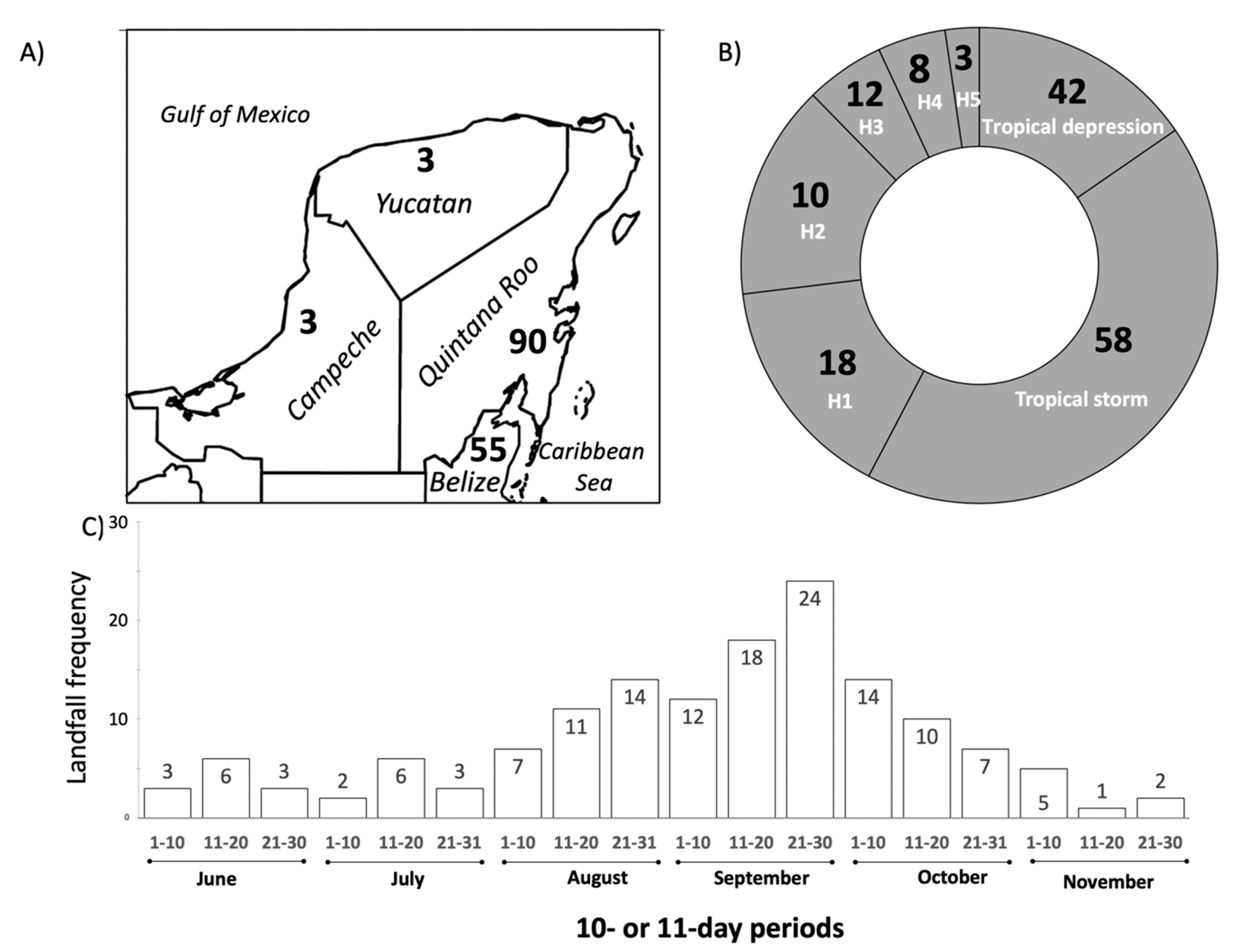

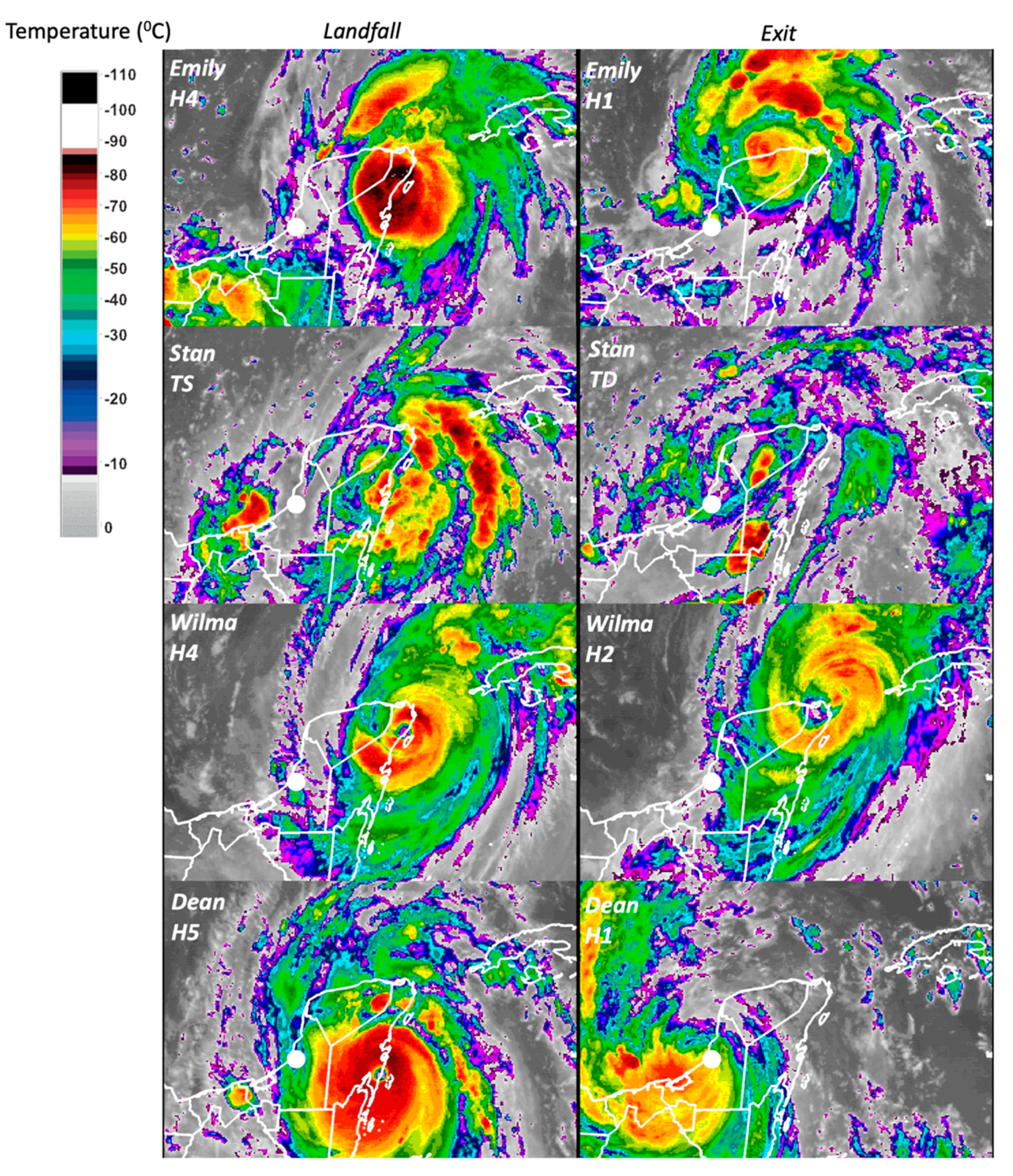
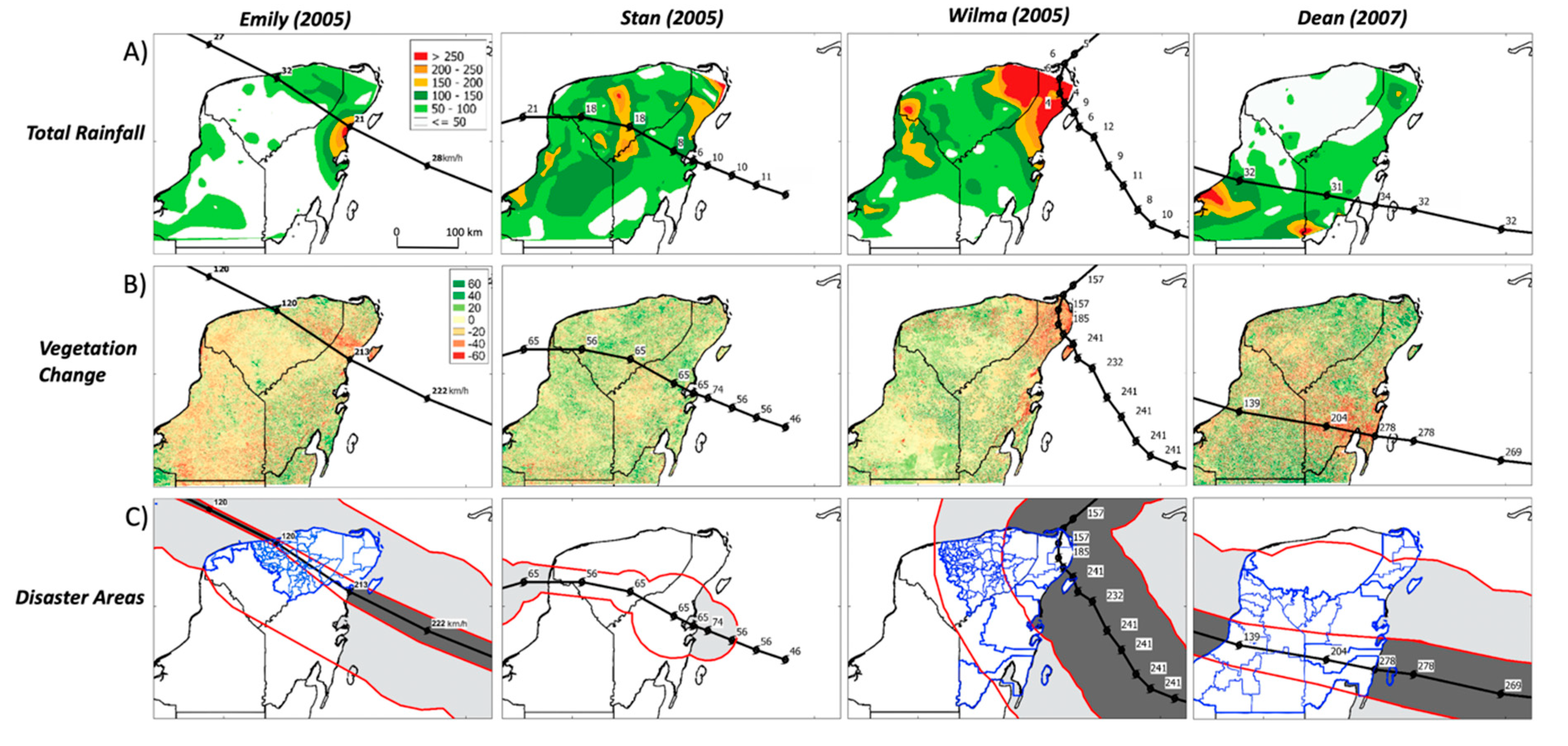
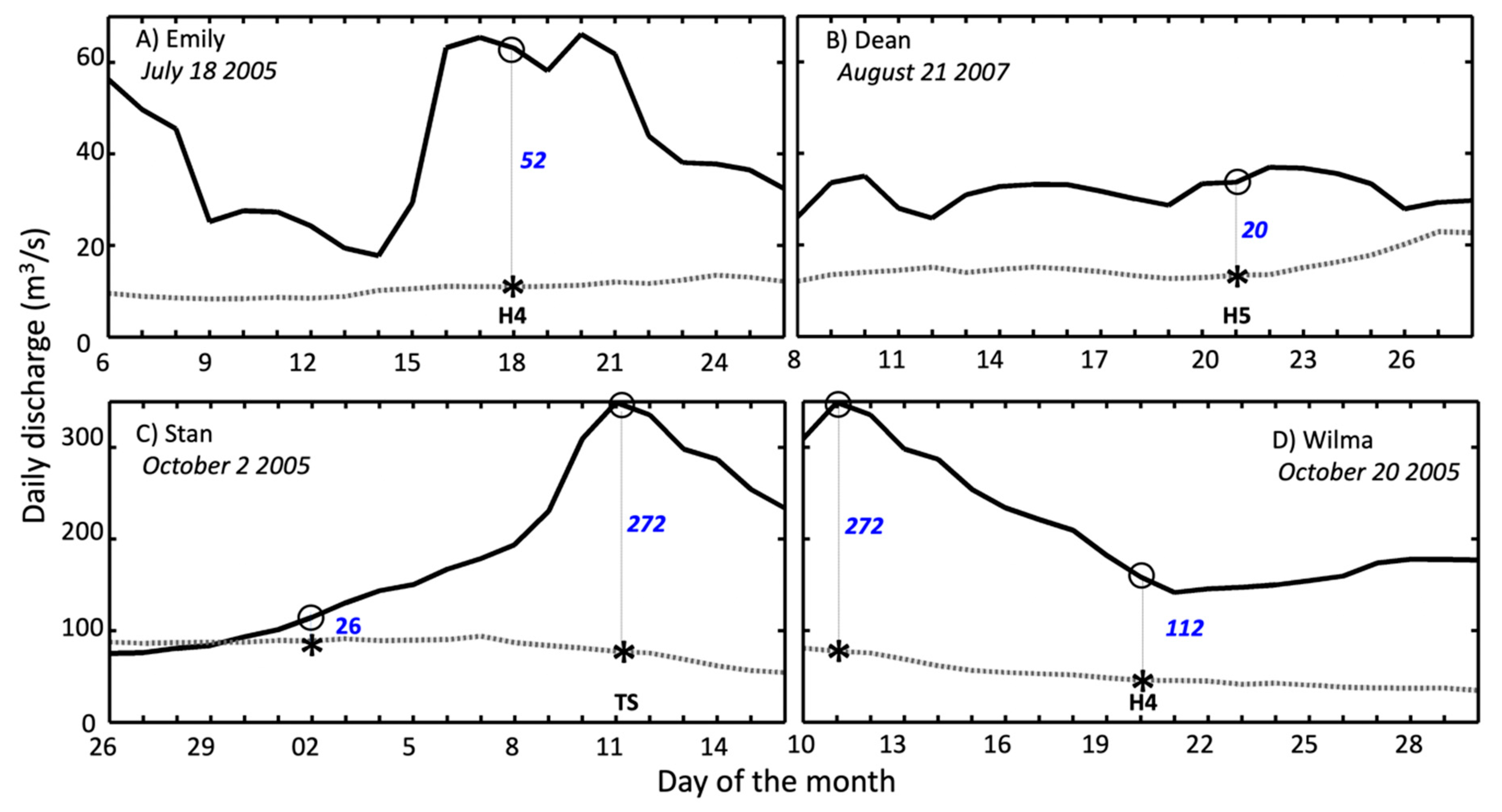
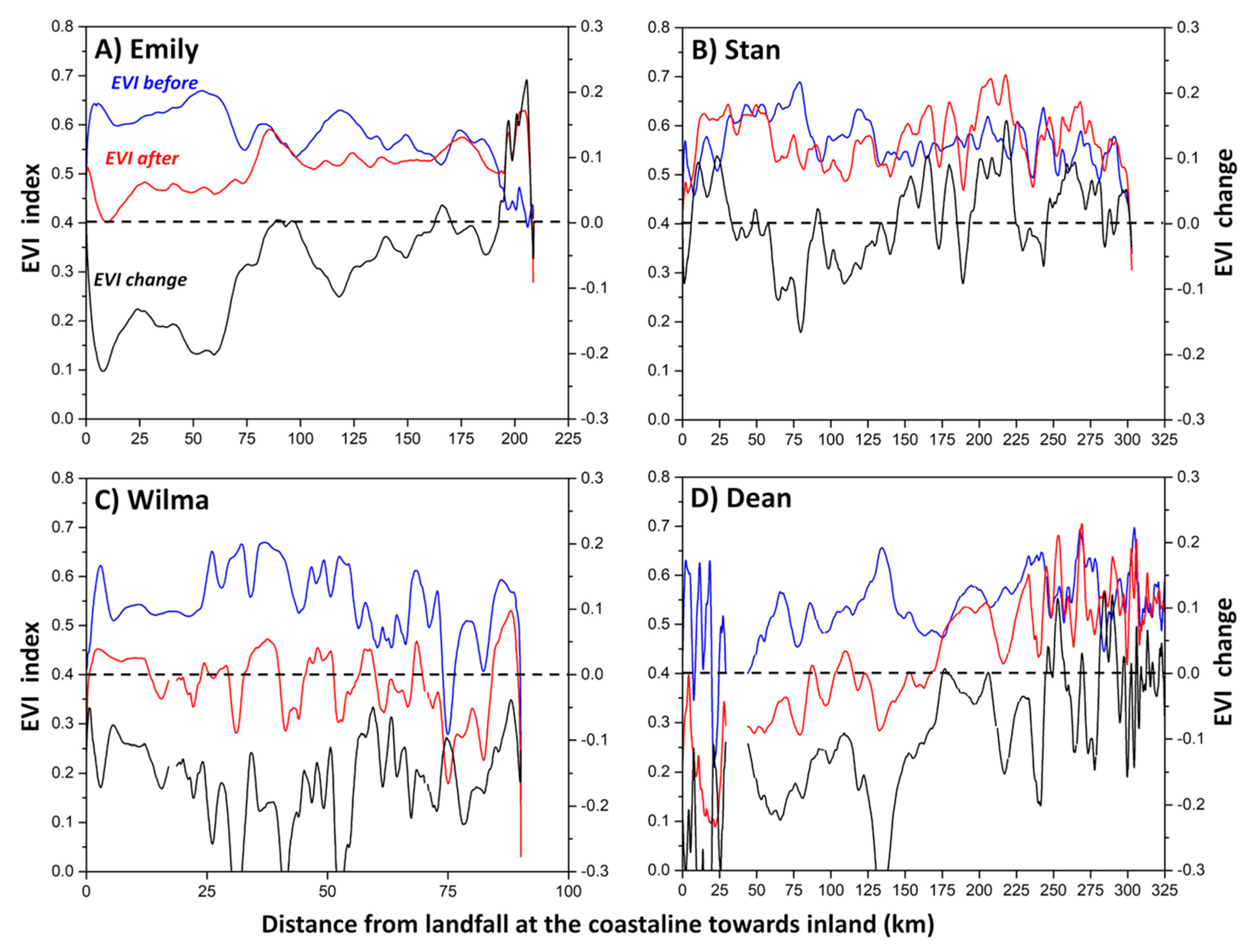
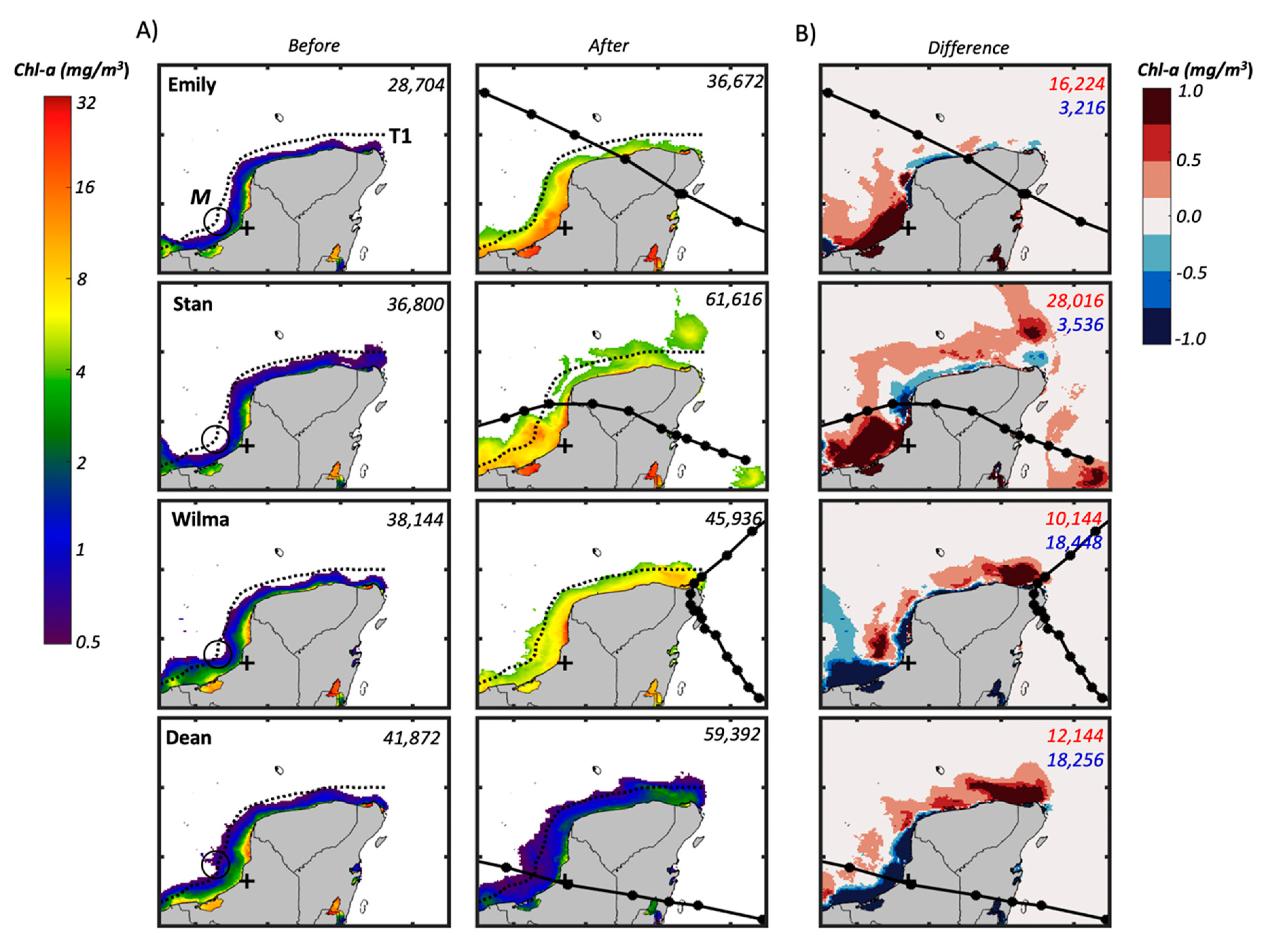
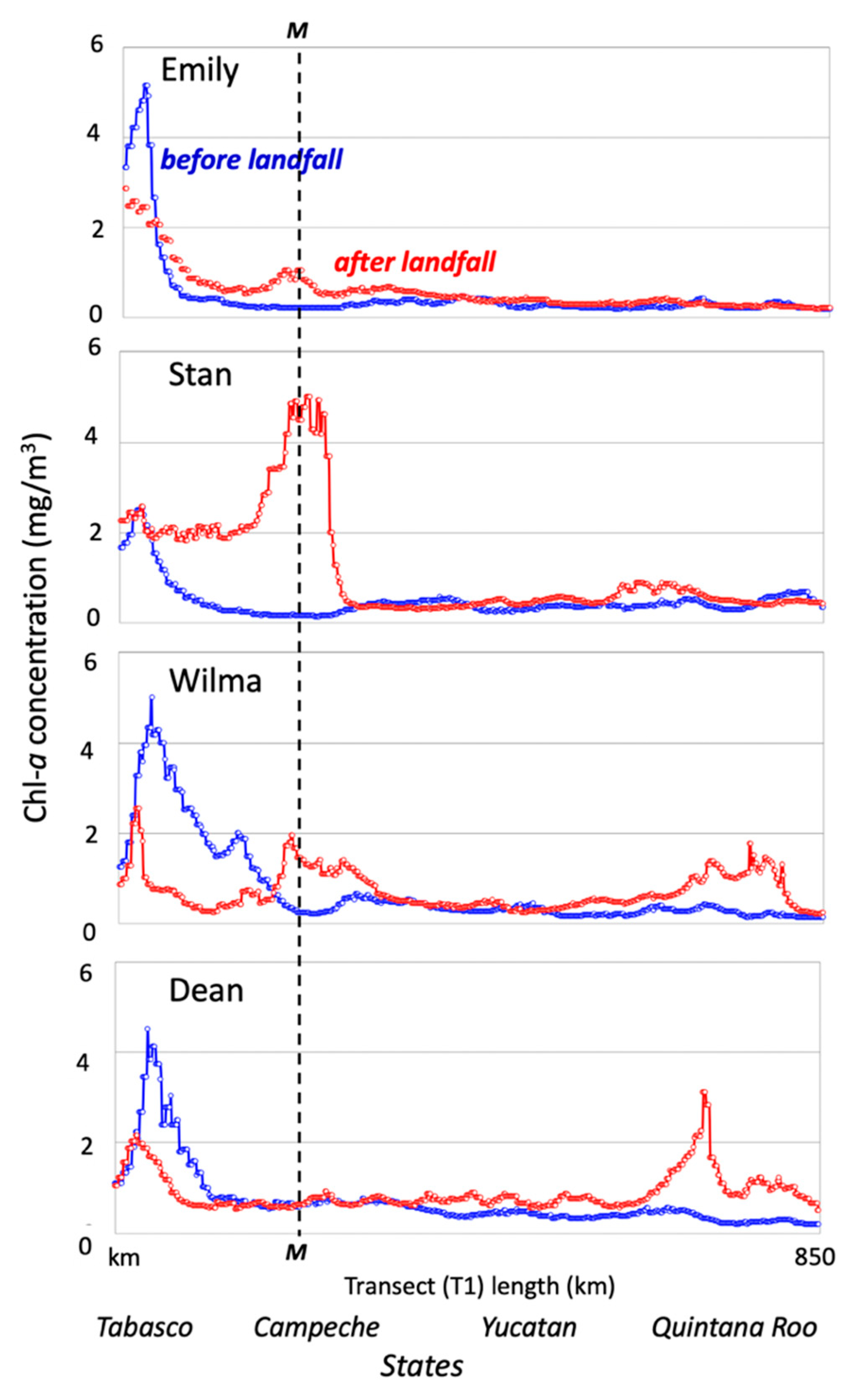
© 2020 by the authors. Licensee MDPI, Basel, Switzerland. This article is an open access article distributed under the terms and conditions of the Creative Commons Attribution (CC BY) license (http://creativecommons.org/licenses/by/4.0/).
Share and Cite
Rivera-Monroy, V.H.; Farfán, L.M.; Brito-Castillo, L.; Cortés-Ramos, J.; González-Rodríguez, E.; D’Sa, E.J.; Euan-Avila, J.I. Tropical Cyclone Landfall Frequency and Large-Scale Environmental Impacts along Karstic Coastal Regions (Yucatan Peninsula, Mexico). Appl. Sci. 2020, 10, 5815. https://doi.org/10.3390/app10175815
Rivera-Monroy VH, Farfán LM, Brito-Castillo L, Cortés-Ramos J, González-Rodríguez E, D’Sa EJ, Euan-Avila JI. Tropical Cyclone Landfall Frequency and Large-Scale Environmental Impacts along Karstic Coastal Regions (Yucatan Peninsula, Mexico). Applied Sciences. 2020; 10(17):5815. https://doi.org/10.3390/app10175815
Chicago/Turabian StyleRivera-Monroy, Victor H., Luis M. Farfán, Luis Brito-Castillo, Jorge Cortés-Ramos, Eduardo González-Rodríguez, Eurico J. D’Sa, and Jorge I. Euan-Avila. 2020. "Tropical Cyclone Landfall Frequency and Large-Scale Environmental Impacts along Karstic Coastal Regions (Yucatan Peninsula, Mexico)" Applied Sciences 10, no. 17: 5815. https://doi.org/10.3390/app10175815
APA StyleRivera-Monroy, V. H., Farfán, L. M., Brito-Castillo, L., Cortés-Ramos, J., González-Rodríguez, E., D’Sa, E. J., & Euan-Avila, J. I. (2020). Tropical Cyclone Landfall Frequency and Large-Scale Environmental Impacts along Karstic Coastal Regions (Yucatan Peninsula, Mexico). Applied Sciences, 10(17), 5815. https://doi.org/10.3390/app10175815







